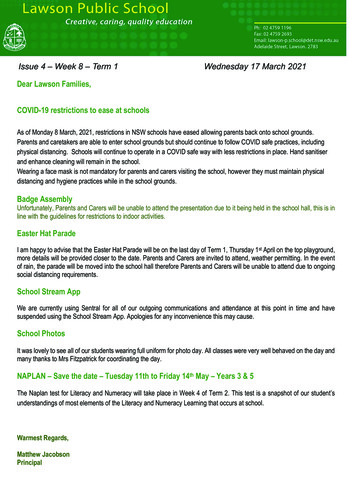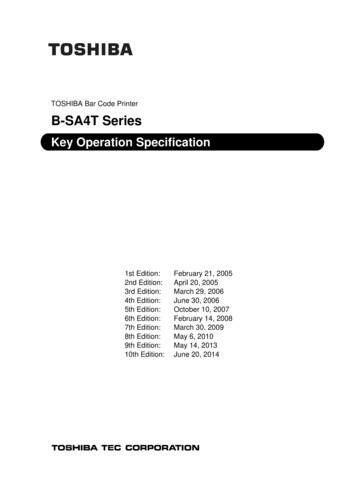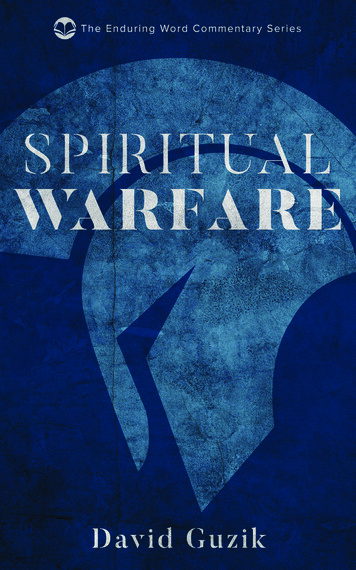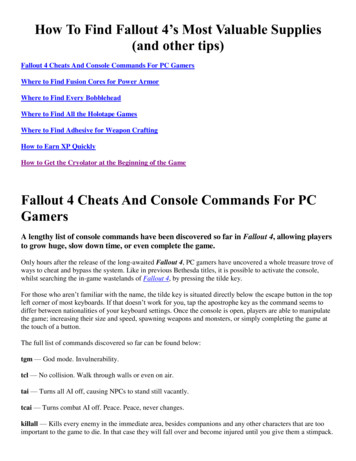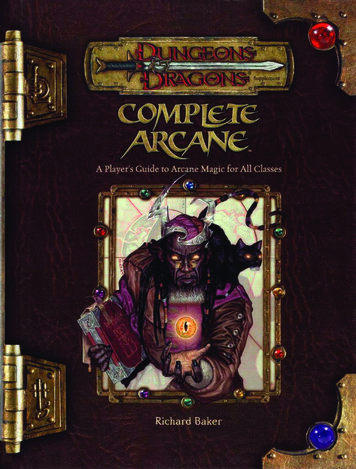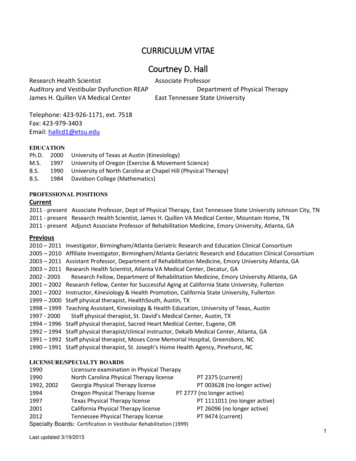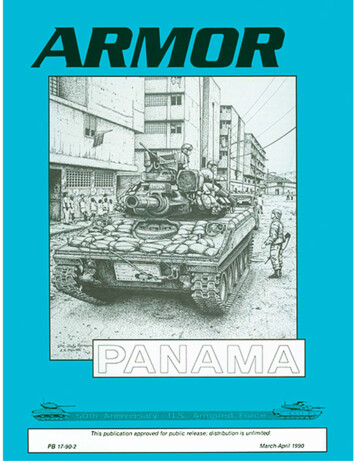
Transcription
It’s spring. That means basketball and the road to the FinalFour. I feel an analogy coming on.Some basketball teams can killyou with the three-point shot,while others are devastating underneath. The better teams havecapabilities both outside and inside, so if you take away onethreat, they’ll get you with theother. But it is excellence in the transition gamethat can put a team out front. It’s the fast break,the steal, the scramble for a loose ball, theblocked shot that not only leads to points onthe board, but demoralizes the opponent.Doesn’t all of this sound exactly like what wedo in cavalry and armor? Firepower, mobility,shock effect.MG Foley states in his ‘Commander’s Hatchthat we are now in transition. How we play thistransition game over the next five years willdetermine whether we pull ahead or fall hopelessly behind. We have spent the past decadeor so working on our heavy, long-rangeshooters. We’ve built up and trained the finestheavy force in the world, only to be on theverge of losing a substantial portion of the teamto graduation. It now appears that future gameswill be won on the inside. (If you think this analogy is beginning to stretch thin, note in the article that begins on page 8 that the Sheridans’engagements in Panama were all between 100and 460 meters.)What we need now are good coaches to helprecruit the new batch of organizations, equipment, and weapons systems we will need forthe new style game we are to play, not a bunchof Dick Vitales spewing their opinions in highpitched voices from the sidelines. The tank isnot dead. The need for firepower, mobility, andshock effect in contingency operations was unscored in Panama. LTG Stiner has said welearned little new on Operation JUST CAUSE,but we verified a lot of what we already knew.Let’s put that to use. A recent seminar at FortBy Order of the Secretary of the Army:CARL E. W O N 0General, United States ArmyChief of StaffKnox on armor support to light forces highlighted a glaring need for more work in thatarena.We must replace the Sheridan. It has done itsduty well, but it’s time to go to pasture. Weneed a system that can move and shoot wellonce it survives its heavy drop. It must be lightenough to traverse bridges in non-industrial nations. (See again “Sheridans in Panama.”) Itmust be able to carry as much of its own supplies and fuel as possible. This will not be aneasy task. If it was, we would have replaced theSheridan years ago.And to cap it off, we can’t afford to spend thenext 15 years in R&D, testing, and production.We need something soon. Developing countriesrepresent 82.2 percent of the total world marketfor arms imports. That is likely to worsen as themajor powers rush to unload suddenly availablesurpluses.Despite the recent events in Eastern Europe,the Soviet Union, and Nicaragua. it is unreasonable to expect a lengthy period of peaceeverywhere. It hasn’t happened since the PaxRomana, and wishful thinking won’t make it happen now.Armor must not play the part of the redheaded stepchild. We must reach in and grabour place in the Army of the 1990s. We must ensure that we are in the championship game ofthe Final Four - and that we win it.- PJCOfficial:WILLIAM J. MEEHAN 11Brigadier General, United States ArmyThe Adjutant General
The Professional Development Bulletin of the Armor Branch PB-I 7-90-2Editor-in-ChiefMAJOR PATRICK J. COONEYManaging EditorJON T. CLEMENSCommandantMG THOMAS C. FOLEYARMOR (ISSN 0004-2420) is publishedbimonthly by the U.S. Army Armor Center, 4401Vine Grove Road, Fort Knox, KY 40121.Disclaimer: The information contained inARMOR represents the professional opinions ofthe authors and does not necessarily reflect theofficial Army or TRADOC position, nor does itchange orsupersede any informationpresented in other official Army publications.Official distribution is limited to one copy foreach heavy brigade headquarters, armoredcavalry regiment headquarters, armor battalionheadquarters, armored cavalry squadron headquarters, reconnaissance squadron headquarters, armored cavalry troop, armor company, and motorized brigade headquarters ofthe United States Army. In addition, Armylibraries, Army and DOD schools, HQ DA andMACOM staff agencies with responsibilityfor armored, direct fire, ground combat systems, organizations, and the training of personnel forsuch organizations may request two copies bysending a military letter to the editor-inchief.Authorized Content: ARMOR will print onlythose materials for which the U.S. Army ArmorCenter has proponency. That proponency includes: all armored, direct-fire ground combatsystems that do not serve primarily as infantrycarriers; all weapons used exclusively in thesesystems or by CMF 19-series enlisted soldiers;any miscellaneous items of equipment whicharmor and armored cavalry organizations useexclusively; training for all SC 12A, 12B, and12C officers and for all CMF-19-series enlistedsoldiers; and information concerning the training, logistics, history, and leadership of armorand armored cavalry units at the brigadekegiment level and below, to include Threat units atthose levels.Material may be reprinted, provided credit isgiven to ARMOR and to the author, exceptwhere copyright is indicated.March-April 1990, Vol XCIX No. 2 eatures8Sheridans in Panamaby Captain Kevin J. Hammond and CPT Frank Sherman16Marines Add Reactive Armor To M6OAlsby Greg Stewart18U.S.Armor Between the Warsby Major Patrick J. Cooney22 An Assessment of the Soviet T-64 Premium Tankby Captain James M. Warford29Brilliant Battalionsby Colonel Len Hawley32 Task Force Smith: A Revised Perspectiveby Captain Robert J. Kmiecik37 The "Fort Knox" of the Germany Armyby Lieutenant Colonel Phillip J. Linn42 Death and Destruction in the Desertby First Lieutenant Mark E. LaDu45Captain, The Truth Changes!by Lieutenant Colonel Pat KnutsonDepartments2 Letters2 Contacts4 Commander's Hatch6 Driver's Seat7 Crossword Puzzle48 Armor Conference Schedule49 Bustle Rack51 Crossword Puzzle Solution52 Books
Time to Reorganize USAREUROn Air Cav Brigade Model?Dear Sir:The articles by General Wagner andMajor Cooney on cavalry, historic and current, In the September-October issue coincided with the remarkable transformationof power in Eastern Europe.However misguided the euphoria of thetelevision network news staffs, et al., therecan be no question that Moscow'sdecision to cut its erstwhile comrades ofDIRECTORYEastern Europe adrift marks the end of anera. In essence, as I read it, the Sovietsare admitting that whatever chance theymay have had for a quick victory inEurope has slipped away, and the cost ofcontinuing to support the illegitimateregimes it established during 1945-48 istoo great.We have our own economic problems.The Bush Administration has made plainthat means taking the loosening of Sovietcontrol in Eastern Europe as a golden opportunity to begin the phaseout of mostU.S. forces in Europe. Let's face it, once- Points Of ContactARMOR Editorial OfficesEditor-in-ChiefMajor Patrick J. CooneyManaging EditorJon T. ClemensEditorial AssistantVivian ThompsonProduction AssistantMary HagerContributing ArtistSPC Jody HarmonWhat would return, if needed, is theAmerican cavalry, either the presentcavary brigade (air combat) or some future derivative.Sad to say, neither ARMOR nor anyother official or quasi-official publicationconnected with the Army ever reported, tothe best of my knowledge, the speech byGen. F. M. von Senger und Etterlin, thencommander, Central Army Group, callingfor reorganization of all NATO armies on(Note: Fort Knox AUTOVON prefix is 464.Commercial prefix is Area Code 5024324-x) )0.U.S. ARMY ARMOR SCHOOL22492249261026102610MAILING ADDRESS: ARMOR, A T l N ATSBAM, Fort b o x , KY 40121-5210.ARTICLE SUBMISSIONS To improve speed andaccuracy in editing, manuscripts should be originals orclear copies, either typed or printed out in near-letterquality printer mode. Stories can also be accepted on5-1/4" floppy disks in Microsoft WORD, MultiMate,Wordperfect, Wordstar, or Xerox Writer (please include a printout). Please tape captions to any illustrations submitted.PAID SUBSCRIPTIONS Report delivery problemsor changes of address to Ms. Connie Bright, circulation manager, (502)942-8624.UNIT DISTRIBUTION: Report delivery problemsor changes of address to Ms. Mary Hager, AV 4642610; commercial: (502)624-2610. Requests to beadded to the free subscription list should be in theform of a letter to the Editor-in-Chief.2out of Europe, heavily armored Americanformations will not return, peace or war.Commandant(ATZK-CG)MG Thomas C. Foley2121Assistant Commandant(ATSB-AC)7555BG J. B. TaylorDeputy Assistant Commandant(ATSB-DAC)COL Claude L. Clark1050Command Sergeant MajorCSM John M. Stephens4952Maintenance Dept.(ATSB-MA)COL James R. Joy8346Command and Staff Dept.(ATSB-CS)5855COL A. W. KremerWeapons Dept.(ATSB-WP)1055COL George R. Wallace I11Directorate of Training & Doctrine (ATSB-DOTD)COL Donald E. Appler7250Directorate of Combat Developments (ATSB-CD)50SOCOL Edward A. BrylaTraining Group(ATZK-TC-TBF)LTC William C. Malkemes3955NCO Academy/Drill Sergeant School(ATNCG)CSM Donald L. Baker5150Director, Reserve Component Spt(ATZK-DRC)COL Charles W. Davis1351Directorate OF Total Armor ForceReadiness(ATZK-TF)7809COL Dennis H. LongTEXCOM Armor & Engineer Board (ATZK-AE)COL Dan E. Deter7850TRADOC Sys Mgr For Tank Systems (ATSB-TSMT)COL Eugene D. Colgan7955ARMOR - March-April 1990
the Sixth Cavalry Brigade (Air Combat)model.Hopefully, we are not going to see an attempt to hang on to and past the point ofirrelevancy the familiar structures of thepast 45 years, as happened in the oldCavalrv Journal.The Soviets, I think, are shedding a substantial part of their heavy forces becausethey got Gen. von Senger und Etterlin'smessage. What a pity it would be if, onceagain, having produced an imaginativeand effective solution to a major strategicproblem, we let someone else develop it,to our ultimate sorrow.does seem to be at least one vehicle typemissing.From my knowledge, there is no currentequivalent to the Churchill AVRE or Sherman "Crab" mine clearing AW. While Itcould be argued that the CEV is themodern AVRE, the CEV does not appearto have the extensive versatility which theAVRE possessed with its numerous brackets for fitting engineer equipment. TheCrab, which used chains attached to adriven rotor drum to beat a path througha minefield, was a highly developedweapon by the war's end. Although I amaware of the new Abrams mine-plow, is itas effective over as a many types ofground as the Flail?WILLIAM V. KENNEDYCOL, Armor, AUS (Ret.)Wiscasset, MaineUse Obsolete ChassisFor Engineer Vehicles?-Dear Sir,A number of recent articles in ARMORhave either dealt with the use of engineerassets in maneuver warfare or with special problems found on the battlefieldwhich need the attention and assistanceof engineers.Although numerous references pertaining to the use of American and Germanengineers are listed as supportingmaterial for the articles, it would seemthat the most innovative use of specialized engineer AWs has been ignored. Perhaps the lessons of the British 79th Armoured Division and its use of specializedarmor should be re-examined.For those who may feel that the multitude of vehicles developed during WorldWar II by the 79th (also known as"Hobart's Funnies") should only be considered as relative to specific problemsfaced by the Allies in the invasion ofFrance, a cursory glance at the currentAVLB and CEV vehicles will show theirdirectoriginfromtheValentineBridgelayer and Churchill AVRE AWsused by the 79th during the war inNorthwest Europe.It would seem that the same problemsexist now as existed some forty yearsago. How does an attacking force breacha defended obstacle, clear a minefield,cross an antitank ditch, cross a blownbridge, ad infinitum? While the AVLB andCEV are very effective vehicles, thereARMORWhat I would like to propose is anotherengineer-specific vehicle. With the introduction of the M1, I expect that a numberof M48A5s and early M60 models will beconsidered redundant and ultimately bescrapped. Instead of wasting thisresource, would it be possible to developa vehicle on a modular principle whichcould be fitted with numerous engineer fixtures? Remove the turret, mount a poweror an auxiliarytake-off from the engineengine, either one positioned in the previous turret basket space and used topower the detachable equipment. Withthe basic vehicle in place, a drum-typemine flail could be developed using someof the same principles as the wartimeCrab. With the removal of the turret, placea stationary rack over the hull on whichfascines could be delivered to breach antitank ditches. Other brackets could bedeveloped for removable bulldozer bladesor bridging units,- March-April 1990Although it would be very tempting toadd so many attachments and tasks thatthe result might make Rube Goldbergproud, some common sense could hopefully prevail through the developmentphase so as to keep the concept relativelysimple.I would think that the greatest benefitsof using the redundant hulls is a vehiclearmored to MBT standards, the removalof the turret, giving the tank an increasedpower-to-weight ratio, and simply that avery versatile vehicle is available to fulfillthe engineer mission.My comments are offered not as aprofessional, but as an interested obsewer and "armchair" historian. In addition, 1 would like to thank you for providing a very informativejournal.Kerry J. BrunnerMilwaukee, Wis.Editor's Note:As we approach the 50th anniversary ofthe Armor Force, we note the passing ofHerbert H. Burr, a WWll tanker who was arecipient of the Medal of Honor for hisheroic acts near Dorrmoschel, Germany,on 19 March 1945. Burr died February 8near his home in Urbana, Mo.In August 1945, Presldent Harry S.Truman presented the Medal of Honor toBurr for driving his flaming tank into a German 8Emm gun position and destroyingit, then returning through a hail of gunfireto rescue a wounded crewman.Burr sewed in the A m y from 1942 to1945 and was discharged as a staff sergeant. He was a PFC bow gunner in the41st Tank Battalion, 11th ArmoredDivision, when his tank was hit by anenemy rocket, severely wounding theplatoon sergeant and forcing theremainder of the crew to abandon thevehicle.Accordlng to the citation: "Private Burrimmediately climbed into the driver's seatand continued on the mission of enteringthe town to reconnoiter road conditions.As he rounded a turn he encountered an8&mm antitank gun at point-blank range.Realizing that he had no crew, no one toman the tank's guns, he heroically choseto disregard his personal safety in a directcharge on the German weapon. At considerable speed, he headed straight forthe loaded gun, which was fully mannedby enemy troops who had only to pull thelanyard to send a shell into his vehicle. Sounexpected and daring was his assaultthat he was able to drive his tank completely over the gun, demolishing It andcausing its crew to flee in confusion."He then skillfully sideswiped a largetruck, overturned it, and wheeling his lumbering vehicle, returned to his company.When medical personnel who had beensummoned to treat the wounded sergeantcould not locate him, the valiant soldierran through a hail of sniper fire to directthem to his stricken comrade. The bold,fearless determination of Private Burr, hisskill and courageous devotion to duty,resulted in the completion of his missionin the face of seemingly impossible odds."Burr was a member of the Congressional Medal of Honor Society and a lifemember of the Veterans of Foreign Warsand the 11th Armored Division Association. He was employed as a painter forthe General Services Administration untilhe retired in 1986.Letters continue on Page 513
MG Thomas C. FoleyCommanding GeneralUS. Army Armor CenterA Small, Highly Lethal,Quality Total ArmorForce for the 1990s .Still the Centerpiece of Mobile,Combined Arms OperationsAs pointed out in our last issue,Armor can be very proud of thelarge part we played in the decisiveCold War victory. Armor can alsobe very proud of the role we playedin the stunning, quick victory inPanama. The 3-73 Armor did anoutstanding job, as is described elsewhere in these pages.Now the Army is moving into aperiod of transition and significantchange. Many mistakenly believethere is no longer a threat - theyare mesmerized by intentions andnot capabilities, and they fail to acknowledge the potential regional armored threats to our national interests. Another major reason forchange is the desire to cut the national deficit. As a result, most ofthe services will decrease in size,beginning this year. This is continued in the President’s FY91budget, which he submitted to theCongress. While the budget is subject to Congressional change and approval, it does reflect the President’s position, and also gives clearsignal of what the future holds.What follows is our assessment ofwhat this means for Armor. Our intent is to keep you updated.4The Army’s plan is to makebalanced reductions in both the Active and Reserve Components andreshape itself into a smaller, yethighly lethal, quality force that isable to meet the needs of our national strategy. Doctrine and warfighting requirements are thedrivers. The end result could be aTotal Army with 270,000 fewer soldiers five years from now.Armor will be greatly affected bythese reductions, which couldremove 27 battalions and squadronsfrom the Total Armor Force overthe next five years. This would leave41 tank battalions and 18 cavalrysquadrons in the Active Component. There would also be fiverecon squadrons, two separate cavalry troops, and one light tank battalion. All this equates to a reduction of roughly 19 percent fromwhere we are today.In the Reserve Components again this is predicated on Congressional approval of the President’sbudget proposal - we would have44 tank battalions, 13 cavalrysquadrons, and 21 separate cavalrytroops. This is about a 17 percentreduction from today.Yet, our branch will play an indispensable role in the Army of the1Ws. We will continue to be thecenterpiece of mobile combinedarms operations as part of our nation’s forward-deployed, contingency, and reinforcing forces. Let usnot forget that contingency forcesrequire a combination of heavy,light, and special operating forces.It would be unwise for the nation tosend light forces into a contingencyor reinforcing situation whereheavier forces are required. Nonetheless, one of our aims must be tolighten the Armor Force so thatboth contingency and reinforcingforces can get more quickly towhere they are needed. Indeed,even the forward-deployed forcescan benefit from such an effort because both their tactical and operational mobility stand to improve. Amajor challenge will be to avoid thetemptation to lighten our fightingsystems to the point where they willbe ineffective against those hostilenations that are equipped withmodem main battle tanks.There are some promising technologies that could result in futureweight reductions without sacrificing survivability. We must pursueARMOR - March-April 7990
these. Another way to accomplishthe goal of achieving force lightnessis to reshape our armor and cavalryorganizations into smaller, yet highly lethal and very agile formationscapable of meeting and defeatingthe likely threats. As part of this, weneed to relook our current mix ofheavy versus light organizations. Forexample, is there a need for morethan one battalion of light armor?Why not three - one at FortBragg, one at Fort Lewis, and oneat Fort Knox with a round-holding, high-leverage fighting arm.Questions like these are a majorthrust of our ongoing combat andtraining development studies andanalyses that we will report on insubsequent issues.In the meantime, we will beginreducing this year. Fewer soldierswill enter the Army, and others willleave earlier than originally anticipated. Some units will standdown. All of this can be very painfuland must be accomplished withgreat care. We will be guided by thefollowing principles:0 Protectquality.0Shape the force for the futureand preserve our historical ties.0 Sustain readiness.0 Usecommon sense.We are closely examining theleader development challenges associated with these reductions. Letme discuss this in some detail. First,some background. As you mayknow, Armor comprises only aboutfour percent of the current TotalArmy force structure. While we areone of the smallest branches, weman almost 30 percent of theArmy’s weapons systems and 60 percent of the heavy maneuver battalions. In short, we are an all-ARMOR- March-April 7990Despite the proposed structurecuts, mentioned above, our officerprofessional development system ofschools will remain, as will the noncommissioned officer education system. Our preliminary analysis indicates that the following leaderdevelopment goals for Armor andCavalry leaders will be achievable:0 We should be able to branchqualify every Armor lieutenant as aplatoon leader during his first assignment.0There should be sufficient o pportunity for all captains to command a company or troop, althoughthe opportunity for a second cornmand will decline.0 Although the Reserve Component portion of the Total ArmorForce will be reduced, the impacton professional development shouldnot be great, but will vary based onstructure cuts from state to state.0 I t is too early to predict theS3/XO opportunity for ma.jors untilwe get better information on officerinventory adjustments. Our goal willbe to continue to afford 18 monthsof S3 or XO experience to deserving majors. This is a key part ofpreparation for battalion command.0 About one-fourth of qualifiedArmor lieutenant colonels shouldcommand battalions. Selection forbrigade-level command will alsocontinue to be very competitive,with about one-fifth being selected.0 Every qualified staff sergeantshould continue to have the opportunity to command a tank or a scoutsection.0 There should be sufficient o pportunity for qualified sergeantsfirst class to be a tank or scoutplatoon sergeant.0 The first sergeant opportunityshould continue to be great - almost 92 percent.0 Competition for selection asCSU will continue to be tough.0 DA will continue to conduct annual promotion and school selectionboards. It is too early to state whatthe opportunities for selection willlook like.More will follow in later issues ofARMOR. All this will be part of theinformation that we will provide toyou as the defense program takesfinal shape, and we are able toreline our vision of the future. Tohelp chart our course into that future, we have established an organization called the Directorate ofTotal Armor Force Readiness(DTAFR). This small office combines the present Directorate ofEvaluation and Standardization andthe Office Chief of Armor. It willtake the Iead at Fort Knox in shaping the Total Armor Force. Seepage 49 for a more detailed description of DTAFFLIn summary, by 1995, we will havetransitioned to a much differentTotal Army than we have today.The shift to a smaller, yet capableforce will require the very best ofour efforts. Teamwork and careful,thorough planning will be a must.One of our most important jobs atthe Home of Armor and Cavalrywill be clearly to define and articulate the role and structure of theTotal Armor Force. Our challengeis to insure that Armor remains thecenterpiece of the combined armsteam, essential to the successful execution of the Army’s warfightingdoctrine. With your help, I’m confident we can do that.Forge the Thunderbolt!5
CSMJohn M. StephensCommand Sergeant MajorUS. Army Armor CenterGetting Their Attention!Over the years all of us have hadto reach back in time to reconstructa proactive situation that led to acohesive effort to solve a problemor to institute a new program.Leadership problems can besolved with little or no effort, ormay require detailed planning andpreparation to execute. As withmost problems, you will probablynot find the solution anywhere butin your past experience. Most experienced leaders have a readysupply of solutions gleaned frompast situations.Fortunately, I have had the opportunity to serve a number of outstanding leaders. In each and every case,the most important quality thatstood out to me was that they “hadmy attention.”What do 1 mean by leaders’responsibility to get someone’s attention? One example that alwayscomes to mind involves an interesting order General James K. Polk issued while commanding the 4th Armored Division. “The M60 tankdoes not get stuck!,” At least, that’sthe way we received it! We were inthe process of drawing new M60tanks. In those days, the general wasthe division commander, but to asergeant, the division commanderwas a long way off. Sometimes soldiers, including leaders, can be hardto control, especially when they geta new weapons system, vehicle, etc.6It’s like a new toy! Evidently, someof the tank commanders thought theM60 could swim. They wouldmaneuver where no one wouldmaneuver a tank FrankenhohenCreek in Grafenwohr. And they gotstuck.After General Polk gave theorder, everyone made a cohesive effort to ensure a tank did not getstuck. The use of reconnaissance,AVLBs. and a lot of common scnsedid the trick. A simple order by ano-nonsensecommanderhadeveryone’s arratfioit!I mentioned the story becausethere are problems occurring at thetank, platoon, and company levelsdirectly related to the leadershipgetting someone’s attention.One tank commander decides notto boresight his tank today, eventhough the rest of the platoon hastaken the time to do so. After thepoint is discussed during the AAR,it is passed off with a “the hell withit” attitude. The platoon sergeanthas not gotten the sergeant’s attention. More important, the incidentoccurs during a live fire evaluation.This means the tank commanderwas allowed to do the same thingduring practice, the leaders of theorganization did not know the unitSOP, or there was no SOP. Nobodygot the NCO’s attention! After theplatoon leader has received his orders and informed the platoonabout its role in the operation, hedecides he has time to spot checkthe vehicles. On one particularvehicle, he notices the S O cat is filthy, and the turret floor is coveredwith trash. Who does he have aproblem with? The tank commander? The platoon sergeant? Hehas a problem with both of them,but he should focus his immediateattention on the platoon sergeant because he has not done his job. Andthe platoon scrgeant has not gottcnthe TC‘s attention!These are two basic problems thatmost leaders say do not exist intheir organization.until they check.Simple orders should be all that isneeded to execute an operation. Hewho stands in the way or jeopardizesmissionaccomplishmentshould not be allowed to exist as aleader. Using excuses like: he isnew, I am breaking him in, or someother tale only prolongs theproblem. If he can tank in CONUS,he should be able to do so overseas,and vice versa. It takes more thantime in grade and service to be acombat leader. Leaders should identify the weak early, assist, and ifleaders can’t get their ATTENTION, remove them.Leaving them in position onlyhinders the success of the organization and the safety of the menunder them!ARMOR - March-April 7990
Soviet Army Operations and TacticsAll words in this puzzle appear in FM 100-2-1 on the page shown following the clue.The puzzle was created bv Thomas Hammett of the Threat Division. USAARMS.1. is one of the most important arHllery missions because ithelps achieve fire superiority. 9-124. Mi-2 light observation helicopter. 9-127. In the defense, the Soviets emphasize disperslon Into company. 6-9sized9. Dismounted troops traveltanks. 5-1112. Smallest fully combined-arms Soviet ground force maneuverelement. 52216. The combat power of Soviet ground forces resides mainly intanks and motorizeddivisions. 1-117. Attack frontage of a motorized rifleis 500800 meters.5-2519. ArHllery command and reconnaissance vehicle (Abbr). 9-620. The forwardelement engages lead enemy forces. 5325-1324. Frontal, flank, and envelopment are basic forms ofto be the main ground force26. The Soviets consider theweapon. 52728. Soviets use the -todeliver strikes at decisive moments in abattle. 9-729. The AT battery, engineer company, and a tank or motorizedreserve. 6-6rifle platoon form the motorized rifle regiment's33. The main Soviet ATGM vehicle. 10-134. Soviets normally breach minefields using -fitted to the leadtanks. 14-235. The BM-21 is arocket launcher. 9-1136. Most probable Soviet attack formation. 523form of combat. 6-837, Defense is a39. To assist movement and enforce march control, each regimenthas acontrol platoon. 5 541. Smoke rounds make uppercent of all artillery units offire. 13-142. Soviet infantry fighting vehicle. 5 1143. The Soviets consider the offense to be the only means to6-1achieve decisive44. Collection of information on enemy location, size, activity, composition, readiness, armament, and intentions. 7-1---.-------.ARMOR- March-April 7990-.2. To achieve depth In the attack, Soviet forces attack in25of fire. 983. Ammunition consumption is based on5. A MobileDetachment provides protection for advancingcolumns by laying minefields. 5-76. An attack from the march is themethod of attack. 5-138. The is a tailored high-speed exploitation force. 2-79. The primary unit for execution of maneuver. 3-1610. Soviet artillery plans for antitank operations in afire mode.10-111. Soviet performance standards, expressed in numerical form.2-1113. Artillery battallon firing positions are generally laid out In thisshape. 9-814. Combat Reconnaissance Patrol (abbr). 5-326-115. Prepared and hasty are the two types of18. Neutralization of antitank weapons in primarily the responsibilityof the -.5-2821. Soviet tanks carry more of these rounds than any other kind ofmunition. 52722. The Chief ofTroops and Artillery Is responsible for thedivisional fire plan. 5-1723. Road junctions, bridges, command posts, and communications
by Captain Kevin J. Hammond and CPT Frank Sherman Marines Add Reactive Armor To M6OAls by Greg Stewart U.S. Armor Between the Wars by Major Patrick J. Cooney An Assessment of the Soviet T-64 Premium Tank by Captain James M. Warford Brilliant Battalions by Colonel Len Hawley Task Force Smith: A Revised Perspective by Captain Robert J. Kmiecik
